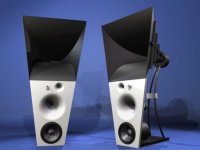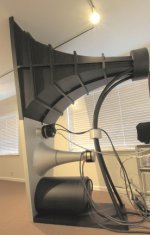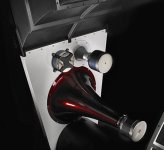So I saw this video yesterday and it got me thinking. How far have we really come in the last 100 years in speaker design.
1928 Western Electric cinema speaker - YouTube
Although it is to big a project for me to do currently, I am curious to know how much better we could make this speaker with current modeling, design, materials and drivers.
Wouldn't be interesting to see how a version of this speaker, using all we have learned would compare to the original?1
1928 Western Electric cinema speaker - YouTube
Although it is to big a project for me to do currently, I am curious to know how much better we could make this speaker with current modeling, design, materials and drivers.
Wouldn't be interesting to see how a version of this speaker, using all we have learned would compare to the original?1
very hard to beat on a number of levels... because the WE engineers and designers were the very best in their day, and they tackled basic problems and found elegant solutions.
The 555 compression driver is still very difficult to beat, difficult if not impossible to copy and get equivalent performance, and sonically extremely good.
Also those WE drivers spawned Altec and JBL directly.
_-_-bear
...besides that's Joe Roberts and JC Morrison... the former being the founder & publisher of Sound Practices Mag, you can figure out who the latter is... 😀
The 555 compression driver is still very difficult to beat, difficult if not impossible to copy and get equivalent performance, and sonically extremely good.
Also those WE drivers spawned Altec and JBL directly.
_-_-bear
...besides that's Joe Roberts and JC Morrison... the former being the founder & publisher of Sound Practices Mag, you can figure out who the latter is... 😀
Last edited:
100 years
Well it's only 85 years so we still have time to prove how much smarter and better we are than those old fools, right?
Well it's only 85 years so we still have time to prove how much smarter and better we are than those old fools, right?
Magico have their $440,000+ speaker called 'The Ultimate Loudspeaker'.
Magico Ultimate II Speaker | Home Theater
Magico Ultimate II Speaker | Home Theater
Attachments
I've worked with the old W.E. stuff.
We can now do smaller, cheaper, louder and more bandwidth.
Those considerations aside, we can't make it "sound better". (IMO)
We can now do smaller, cheaper, louder and more bandwidth.
Those considerations aside, we can't make it "sound better". (IMO)
Man, how'd they get that monstrosity all the way to Germany? Joe sure has changed over the years. I met him about 20 years ago, before he moved to Texas.
Without a doubt vintage speakers do have a certain sound - that probably only 100 years of aging could duplicate. 😛
One of the neatest speakers I have ever heard was the Atwater Kent Type E. It is VERY clear, has a very hi-fi sound - but I don't think I need to get into the flaws of this type of speaker, which are many.
I think it would be cool to try to duplicate the old WE sound, which can be done largely by Bakelite diaphragms, open back cabinets, field coil drivers, etc. - but it's all about chasing nostalgia, IMO. I've looked at a lot of this stuff, and the fact is if one wants better sound there is simply no beating modern drivers, materials, and methods.
I get the draw to old speakers and the like, I really do, but not to look back at it as an ideal, which is the equivalent of saying the epitome of the car was the Model T, and it has all been downhill ever since. That is just flat out false - unless the criteria is a nostalgic ideal. Then, of course, there IS only one way to go. 😉
One of the neatest speakers I have ever heard was the Atwater Kent Type E. It is VERY clear, has a very hi-fi sound - but I don't think I need to get into the flaws of this type of speaker, which are many.
I think it would be cool to try to duplicate the old WE sound, which can be done largely by Bakelite diaphragms, open back cabinets, field coil drivers, etc. - but it's all about chasing nostalgia, IMO. I've looked at a lot of this stuff, and the fact is if one wants better sound there is simply no beating modern drivers, materials, and methods.
I get the draw to old speakers and the like, I really do, but not to look back at it as an ideal, which is the equivalent of saying the epitome of the car was the Model T, and it has all been downhill ever since. That is just flat out false - unless the criteria is a nostalgic ideal. Then, of course, there IS only one way to go. 😉
The diaphragm in a WE 555 is NOT a bakelite diaphragm... fyi.
I am not familiar with any WE stuff that uses bakelite as a diaphragm material.
Aluminum, paper and phenolic, afaik.
The horn on the tweeter they made (can't recall the number now) that may have been phenolic, not sure.
They also did not use open back cabinets.
Field coils are not inferior at all. They are more expensive, which is the main reason that manufacturers went to permanent magnets, to save money, and make things more compact. There are some advantages to field coils actually.
Not all WE stuff is outstanding, and clearly not *most* old gear is even good. But there is no doubt that amongst the best compression drivers today, that the 555 is up there with the best. The large format horns that WE made are rather impressive too... not nearfield monitors or for tiny rooms though.
Equaling the performance of the 555 is not something that *any* driver I know of today is doing. It is unique in that regard. Look into it!
The use of "modern" drivers, materials and methods unfortunately does not assure or guarantee anything like "good sound". It is all a series of compromises, yin/yang, and choosing which are acceptable and can be lived with. No panacea in modern speakers at all. With that in mind, and given the space requirement, few speakers can compete with a 555 driver on a WE horn even today. Unlike automobiles where very few cars from the 1930s would compete with modern ones (there are some though...), the best of the WE stuff is up to today's standards. The comparison to the Model T is not valid as the things that are equivalent in audio pre-date the WE designs, and the WE designs were intended to provide orders of magnitude improvements over what were "Model T" age sound systems.
_-_-bear
I am not familiar with any WE stuff that uses bakelite as a diaphragm material.
Aluminum, paper and phenolic, afaik.
The horn on the tweeter they made (can't recall the number now) that may have been phenolic, not sure.
They also did not use open back cabinets.
Field coils are not inferior at all. They are more expensive, which is the main reason that manufacturers went to permanent magnets, to save money, and make things more compact. There are some advantages to field coils actually.
Not all WE stuff is outstanding, and clearly not *most* old gear is even good. But there is no doubt that amongst the best compression drivers today, that the 555 is up there with the best. The large format horns that WE made are rather impressive too... not nearfield monitors or for tiny rooms though.
Equaling the performance of the 555 is not something that *any* driver I know of today is doing. It is unique in that regard. Look into it!
The use of "modern" drivers, materials and methods unfortunately does not assure or guarantee anything like "good sound". It is all a series of compromises, yin/yang, and choosing which are acceptable and can be lived with. No panacea in modern speakers at all. With that in mind, and given the space requirement, few speakers can compete with a 555 driver on a WE horn even today. Unlike automobiles where very few cars from the 1930s would compete with modern ones (there are some though...), the best of the WE stuff is up to today's standards. The comparison to the Model T is not valid as the things that are equivalent in audio pre-date the WE designs, and the WE designs were intended to provide orders of magnitude improvements over what were "Model T" age sound systems.
_-_-bear
Last edited:
Quite true, of course, and I agree there is some very old stuff that still does very well as a statement of the art, as I tried to point out in my example.The use of "modern" drivers, materials and methods unfortunately does not assure or guarantee anything like "good sound".
The diaphragm in a WE 555 is NOT a bakelite diaphragm... <snip> phenolic
You know that Bakelite is also a phenolic, yes? 🙂
I really didn't want to argue it.... 😛You know that Bakelite is also a phenolic, yes? 🙂
Let's see if I undertand. Bakelite, the resin, is usually supported by a scrim such as silk (early days) or other woven fiber and the phenolic in diaphragms is usually paper?
My understanding is that both are resins produced through strong chemical and heat reactions with phenol and formaldehyde. Bakelite is the more pure form, more of a primitive plastic, while the product 'phenolic' usually has a wood filler.
Otherwise, pretty much the same thing.
Otherwise, pretty much the same thing.
I get the draw to old speakers and the like, I really do, but not to look back at it as an ideal, which is the equivalent of saying the epitome of the car was the Model T, and it has all been downhill ever since. That is just flat out false - unless the criteria is a nostalgic ideal. Then, of course, there IS only one way to go. 😉
I agree with this statement. We had long debates over at Classic Speakers between those that thought 1960s AR speakers were "great for their time" or "the best speakers of all time".
The real changes in the last 85 years are our ability to measure, our ability to computer model, available materials (plastic and new metals for diaphragms), higher temperature adhesives, new hgher energy magnet materials, a better understanding of room acoustics, a somewhat better understanding of psychoacoustics.
Everything leading up to the loudspeaker is also infinitely better.
Still, it doesn't guarantee that the old stuff is bad or that the new stuff is good, we just have less of an excuse for designing bad speakers these days.
David S.
You know that Bakelite is also a phenolic, yes? 🙂
Or to put it another way, Bakelite was just a trade name for phenolic.
se
Wow some of you guys sound a little defeatist. Are you are trying to tell me that we have not improved speakers in EVERY respect since 1928? That is just ridiculous.
The way I would do this would be to look at the speaker and break it down into parts and remodel it with modern techniques. The speaker would be setup in the same configuration. For example, the understanding of horn dimensions, and their affect on the sound has been greatly improved over the past 100 years. In fact horns and wave guides have been making a resurgence and what is old is new again. I would take the mid horn section and remodel it using everything we now know about horn design. I guess a better way to put it would be to optimize the design using modern techniques.
The drivers may be special but that doesn't mean we couldn't build a newer version of the driver using modern techniques, materials and technology. In fact, if this driver was so amazing I am surprised someone hasn't done this already.
In the end you would have a speaker that would look similar but that would sound a whole lot better, how much better is the real question. I am not of the party that thinks vintage sounds good for the sake of it being vintage.
The way I would do this would be to look at the speaker and break it down into parts and remodel it with modern techniques. The speaker would be setup in the same configuration. For example, the understanding of horn dimensions, and their affect on the sound has been greatly improved over the past 100 years. In fact horns and wave guides have been making a resurgence and what is old is new again. I would take the mid horn section and remodel it using everything we now know about horn design. I guess a better way to put it would be to optimize the design using modern techniques.
The drivers may be special but that doesn't mean we couldn't build a newer version of the driver using modern techniques, materials and technology. In fact, if this driver was so amazing I am surprised someone hasn't done this already.
In the end you would have a speaker that would look similar but that would sound a whole lot better, how much better is the real question. I am not of the party that thinks vintage sounds good for the sake of it being vintage.
Yes, phenol resins... but the resulting materials properties are rather different?
Ok Dave, so everything leading up to a new loudspeaker *is* better.
Where are these many *better* sounding speakers to be found?
LafeEric, the Atwater Kent (was that it?) isn't terribly representative of the WE capabilities, so it remains at least to me to be a poor example.
_-_-bear
Ok Dave, so everything leading up to a new loudspeaker *is* better.
Where are these many *better* sounding speakers to be found?
LafeEric, the Atwater Kent (was that it?) isn't terribly representative of the WE capabilities, so it remains at least to me to be a poor example.
_-_-bear
Well said David S....Still, it doesn't guarantee that the old stuff is bad or that the new stuff is good, we just have less of an excuse for designing bad speakers these days.
- Home
- Loudspeakers
- Multi-Way
- Western Electric 1928 - How far have we come in the last 100 years?


